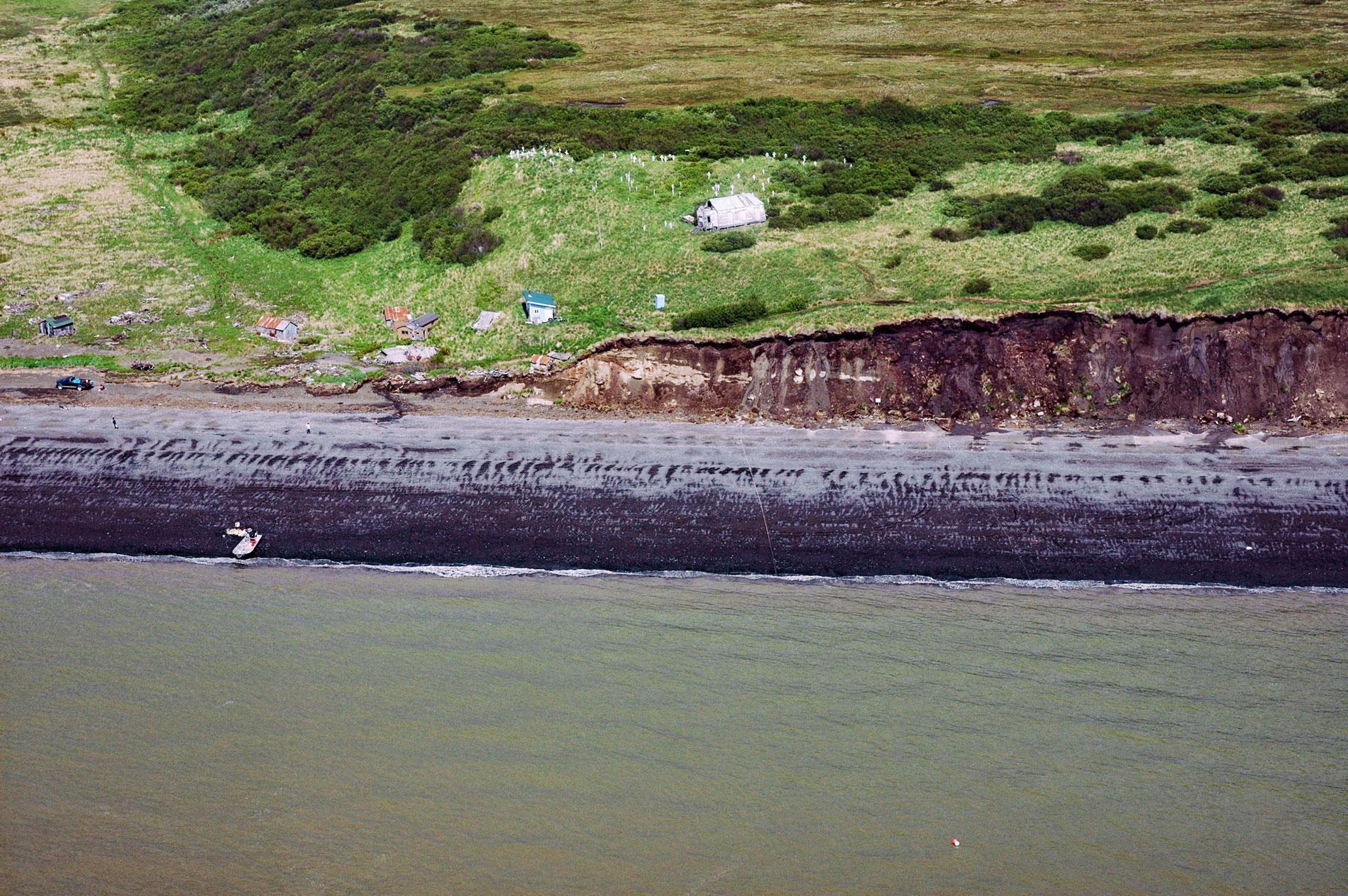Saint Nicholas Chapel is a historic Russian Orthodox church situated on a bluff overlooking Ekuk Spit and the summer set-net community of Ekuk, on the eastern shore of Nushagak Bay, about 16 miles (26 km) south-southwest of Dillingham and 2 miles (3.2 km) south-southwest of Clarks Point, Alaska. Ekuk was originally an Aglegmiut Yup’ik settlement first reported in 1822 by Russian naval officer Vasili Stepanovich Khromchenko. The Yup’ik name reputedly means ‘the last village down’ referring to it being the farthest village south on Nushagak Bay. Ekuk Spit is a depositional landform consisting of successive accretional beach ridges that extend north for 1.5 miles (2.4 km) from Ekuk Bluff and enclose an extensive marshy area incised by numerous tidal sloughs. The bluff is 65 to 80 feet (20-25 m) high and comprises unconsolidated glacial sediments of the Ekuk Moraine. Accretion is on-going at the north end of the spit supplied by sediments eroded from the steep bluffs to the south. Wind-driven waves from the west and south, and summer vehicle traffic on the beach are causing and contributing to most of the coastal erosion. Ekuk Bluff eroded about 125 feet (38 m) between 1912 and 1981, and an additional 65 feet (20 m) from 1981 to 2006, suggesting an annual rate of erosion at 2 to 3 feet (0.6-0.9 m) per year.
During the early 19th century there were four large and important settlements along Nushagak Bay; Ekuk, Kanakanak, and Nushagak on the east side, and Kanulik on the western shore. The first well-documented contact between these Yup’ik-speaking people and Europeans took place in 1818 when a party of Russian-American Company employees was sent from Kodiak Island to explore the territory north of Bristol Bay. During these explorations, Aleksandrovski Redoubt, the company’s first post north of the Alaska Peninsula, was established near the village of Nushagak. The post was used as a base of operations to explore and open the interior regions to the fur trade. In 1822, Khromchenko anchored off the Ekuk Bluff and residents of the village came out to the ship in baidarki. and transferred his crew and equipment by small boat to the trading post. From that time on Yup’ik guides from Ekuk were used by most vessels bringing supplies to Aleksandrovski Redoubt, their captains being unwilling to risk running aground on the treacherous tidal flats of the bay. In 1903, the North Alaska Salmon Company opened a cannery on Ekuk Spit, but most Yup’ik residents of Ekuk had moved to either the Moravian Mission near Nushagak or to other canneries in Nushagak Bay. In 1916, Libby, McNeill & Libby purchased the cannery and operated the facility until it was sold to Columbia Ward Fisheries which became Wards Cove Packing in the 1980s. In 2002, the Ekuk Plant was closed because of the drop in salmon prices, and in 2005, the cannery was purchased by Ekuk Fisheries. Ekuk is now inhabited mainly by seasonal fishing families who set gillnets for mid-summer runs of sockeye salmon, early season runs of Chinook salmon and late season runs of coho salmon.
The first Russian Orthodox church north of the Alaska Peninsula was established at Aleksandrovski Redoubt in 1841 and missionaries began to penetrate the Nushagak River country. However, they were seldom able to visit the villages in this vast area more than twice a year and it is likely that the residents of these villages were marginal participants in the newly introduced faith. A Russian Orthodox church was reported in 1890 situated at Ekuk village on top of Ekuk Bluff, but according to church records, a priest seldom visited the village. Following the Alaska Purchase in 1867, the Russian Orthodox Church continued to send priests into the interior and was the major religious influence in the area as it is today. In 1886, the Moravian Church established a mission and school called Carmel at the village of Kanulik on the western shore of Nushagak Bay, but its influence was never great, and the mission was abandoned in 1905. In 1918 or 1919, a new church called Transfiguration of our Lord Chapel was constructed at Ekuk as a simple rectangle, approximately 21 feet (6.4 m) long and 16 feet (4.8 m) wide and covered by a low-angle hip roof on property owned by the Russian Orthodox Church. The chamber was subsequently lengthened and is now 34 feet (10.4 m) long. The modest structure is registered in the National Register of Historic Places, although were it not for the exterior religious symbols, it might be mistaken for a rural schoolhouse. Read more here and here. Explore more of Ekuk and Nushagak Bay here:

